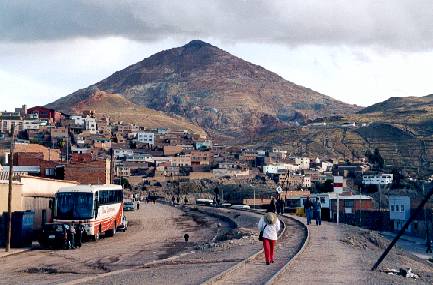10 December 2002: Potosí, Bolivia
Subject: Bolivia
Potosí
I am writing this in what claims to be the Highest Cybercafe In The World - 4000m up in the Andees. We're spending a day in the historical city of Potosí, whose fame depends on the enormous silver deposits that have been mined in its mountain since shortly after the conquest. The Spaniards, in their insatiable desire for precious metals, enslaved the enitre male population of "greater Peru" to work in Potosí's mines for some proportion of the time. The city grew to be the largest in Chirstendom after London, Paris and Seville - if you can really call it part of Christendom since the miners still very actively worship pre-conquest deities, and even the Devil, to whom the say that everything under the ground belongs. Here is a photo of the hill, Cerro Rico, that the mines are underneath.

The mines are still actively worked, though other metals are now more important than silver. The conditions are utterly attrocious and the life expectency of a miner is 42 years, mainly due to silicosis. Of course they are not slaves any more, so why do they do it? Although Bolivia is a poor country there are clearly better options open to them. I can only imagine that it is the lottery player's skewed perception of chance: every miner imagines that they will be the one to find some rich vein that will make their fortune.
Anyway, all these old riches have given the city some nice old architecture (big old doorways are the main things you see from the street) and plenty of churches. This afternoon we went on a tour of the Museo Santa Teressa, a former convent of a closed order. At its largest it was built around eighteen courtyards, but as the city's riches declined it contracted to only three. Finally, within the last few decades, the nuns moved into a corner of the site and the majority was turned into a museum - and a very good one.
Of course it is full of religious art, of which we have seen lots recently. But here much of it had been recently restored, the frames repaired and re-guilded and the pictures cleaned, making them much more striking. Apparently when a girl, normally from a noble family, was sent to the convent she took a "dowry". This could be cash or the equivalent value in religious art, and this is where it all came from. We saw one set of vestments that had been made by a novice from the clothes that she arrived in: of course she wore only a habit as a nun. Another thing (what is the word for a religious apron?) was made with silver and gold thread and weighs five kilograms!
The building itself is interesting, as are the courtyards which are all full of plants and a three hundred year old apple tree that still fruits. But probably most interesting of all was to see the way of life that the nuns lived until very recently. They have a lovely old kitchen, and you can see a reconstructed cell. But most interesting was to see how they communicated with the outside world - or rather how they failed to communicate with it. They had a revolving thing where goods could be put on one side by a tradesman and spun around to enter the convent, with money going back in return. Then there were the arrangements for nuns to communicate with their parents, who were allowed to come for an hour a month. They were separated by a five-foot-thick wall with a large hole cut in it. On the outside this hole had a grid of wrought iron bars with spikes pointing out from them. On the inside there was a thick black curtain. So the families could talk to, but not see, their daughters. This carried on until, can you believe it, 1965. After "Vatican II" in 1965 they replaced the black curtain with a piece of glass so they can see each other. I do wonder what we would think if this was going on in Afghanistan or somewhere else where human rights are in the West's spotlight, rather than in a "Christian" country.
Anyway, it was an excellent visit; interestingly one of the best museums in Cusco was also a former convent so maybe it's something worth looking out for.
Miracle Drug Discovered!
I am pleased to report that the "Wonder Miracle Drug" Ciprofloxacin has cured all my recent digestive ills. This stuff is great: it will cure everything from Anthrax to Diarrhea. Visitors to Bolivia, take it from day one and you'll be fine!
Uyuni
Tommorrow we're off to Uyuni, next to the world's largest salt lake. All being well in a few days we'll be across the other side in Chile's Atacama desert. More news then.